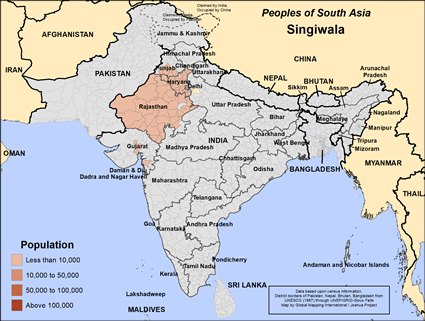Singiwala in India

Send Joshua Project a photo
of this people group. |

Map Source:
People Group data: Omid. Map geography: UNESCO / GMI. Map Design: Joshua Project
|
| People Name: | Singiwala |
| Country: | India |
| 10/40 Window: | Yes |
| Population: | 17,000 |
| World Population: | 17,000 |
| Primary Language: | Hindi |
| Primary Religion: | Hinduism |
| Christian Adherents: | 0.00 % |
| Evangelicals: | 0.00 % |
| Scripture: | Complete Bible |
| Ministry Resources: | Yes |
| Jesus Film: | Yes |
| Audio Recordings: | Yes |
| People Cluster: | South Asia Dalit - other |
| Affinity Bloc: | South Asian Peoples |
| Progress Level: |
|
Introduction / History
The Singiwala are a small low class group of people who live in Rajastan, India. Their name means pipe holder. Their traditional occupation was sucking bad blood and pus from wounds. In other words they were low-level surgeons for the poorer classes of Indians. Most of the Singiwala who were Muslims migrated to Pakistan during the Indian-Pakistani Partition of 1947. The Hindu Singiwala remained in India.
Today many Singiwala are landless farm laborers. They are a Scheduled Class, which means the Indian government reserves special places for the Singiwala in public jobs and college admission. Unfortunately, most Singiwala cannot read or write. They are still seen as outcastes in much of Indian society. The primary language of the Singiwala is Hindi. Some speak Rajastani so they can communicate with their neighbors.
Where Are they Located?
The majority of the Singiwala live in the west Indian state of Rajastan. Some also live in Haryana and Delhi.
What Are Their Lives Like?
The traditional job of the Singiwala, low-level surgery, is disappearing in modern India. They have had to take up new occupations as farm laborers, factory workers or any other menial jobs they can obtain. Lack of education prevents the Singiwala from getting any but the lowest type of jobs. They are not welcome by the majority Hindus of India. The Singiwala often have to move from place to place just trying to get enough income to feed their families.
The Singiwala are endogamous, that is they marry within their group. Girls often marry in the mid-teens and boys in their late teens. Families arrange marriages. They eat meat except for beef when they can afford it. Most of their food consists of wheat, maize and seasonal vegetables. Alcoholism is reported to be a problem among the Singiwala, which is understandable considering their bleak status. Smoking is common among the men.
What Are Their Beliefs?
The vast majority of the Singiwala practice Hinduism, the ancient religion of India. Even though they are often denied entrance into Hindu temples and shunned by other Hindus, they remain in their traditional religion. Their goal is to attain moksha that is to break free of the endless cycle of being born and reborn, samsara. They hope to achieve liberation through performing rituals and good works.
As Hindus, the Singiwala participate in the yearly holidays of Holi, the festival of colors, Diwali, the festival of lights and Navratri, the nine-day celebration of autumn.
What Are Their Needs?
The Singiwala have tremendous needs. Most of all they need to hear the life-changing gospel of Jesus Christ. The Singiwala children must be educated if they are to have any chance of bettering themselves. The Singiwala adults need job training so they can make enough money to live a decent life.
Prayer Points
Pray that the Lord leads Indian Christians to reach out to share the gospel with the Singiwala and help them in practical ways.
Pray that Christian teachers would help the Singiwala learn basic literacy so they can read the Bible on their own.
Pray that Christian audio resources would be available to the Singiwala so that they can hear the gospel in an accessible way.
Pray that the Singiwala would turn away from a religion, which rejects them, and turn to the God of the Bible who loves them.